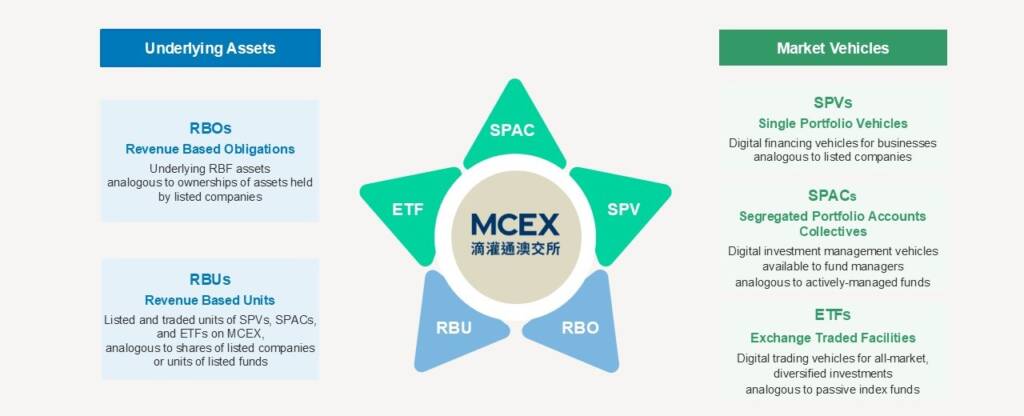Charles Li
Founder's Blog
Today, we announced the launch of a new market operating structure of MCEX called the Micro Star. This marks a significant milestone for MCEX and brings us another step closer to our vision to pioneer a new capital market that is more inclusive and accessible, in particular to micro and small businesses around the world.
As the world’s first licensed revenue based financing (RBF) exchange, MCEX introduces a new market that is structurally modeled after the traditional equity market but with three distinctive innovations:
- A Digital Market Structure — we have taken a page from traditional finance to create a range of digitally-enabled vehicles in order to make our new market lighter touch and more cost effective, hence more accessible to micro and small businesses.
- A Distribution-driven Market — we have established a new market regime that requires issuers to (1) distribute essentially all of their revenue as monthly (or more frequent) cash payouts and (2) provide future monthly distribution forecasts, both to be executed, recorded, and disclosed on our exchange system. The new standard substantially lowers the market barriers to entry for micro and small businesses while maintaining high levels of investor protection.
- A Dividend-based Trading Model — we have introduced a dividend-based trading model in order to deliver a more flexible and nimbler product to satisfy the diverse needs and risk appetite of market participants and to allow capital formation to develop incrementally.
In this blog, I will share my thoughts and rationales behind the “3D” innovations and how they will be instrumental in realizing our vision to build a more inclusive financial market for all.
We Have Created a Digital Market Structure Modeled After the Traditional Market
We have taken the market structure logic of the stock market but have digitally replicated its key features to give micro and small businesses what they care about the most: lighter touch, lower cost, and higher efficiency.
The Micro Star system is the overall digital operating infrastructure of MCEX and comprises five core components: RBOs, SPVs, SPACs, ETFs, and RBUs.

The Five Core Components of the Micro Star Digital Operating Infrastructure
The five core components of the Micro Star closely resemble their structural equivalents in the traditional market:
- RBOs (Revenue Based Obligations) are MCEX-listed underlying RBF assets in our market, corresponding to ownerships of assets and operations held by listed companies in the stock market.
- SPVs (Single Portfolio Vehicles) are MCEX-listed digital financing vehicles for businesses, analogous to listed companies in the stock market.
- SPACs (Segregated Portfolio Accounts Collectives) are MCEX-listed digital investment management vehicles available to fund managers, analogous to actively managed listed funds in the stock market.
- ETFs (Exchange Traded Facilities) are MCEX-listed digital trading vehicles for index-tracking and/or all-market, diversified investments operated in accordance with the rules of MCEX, analogous to passive index funds in the stock market.
- RBUs (Revenue Based Units) represent the listed and traded units of SPVs, SPACs, and ETFs on MCEX, analogous to shares of listed companies or units of listed funds in the stock market.
In sum, RBOs, SPVs, SPACs, ETFs, and RBUs are all digital, virtual instruments, as opposed to legal entities organized under corporate law, securities law, or fund regulations. Our digital market structure retains the design of securitized units that underpins traditional finance while providing a cost-effective and process-light regime for micro and small businesses to connect with institutional and professional investors in the traditional market, making MCEX their “listing venue of choice”.
Today, we are excited to welcome the listing of the first 38 SPVs (which include brick-and-mortar consumer retail businesses and e-commerce merchants from Mainland China, Hong Kong, Macao, and overseas) and 25 SPACs (comprising portfolios sponsored by professional fund managers, securities brokerages, RBF platforms, and e-commerce enablers). We are also thrilled to announce the listing and trading of the first ETF, which consists of the RBCs / RBOs originated through Micro Connect’s proprietary investments over the past three years.
This is a Distribution-driven Market that Requires Cash Distributions and Forecasts
We have established a new market regime that requires issuers to (1) distribute essentially all of their revenue as monthly (or more frequent) cash payouts and (2) provide future monthly distribution forecasts; both to be executed, recorded, and disclosed on our exchange system. The new standard substantially lowers the market barriers to entry for micro and small businesses while maintaining high levels of investor protection.
MCEX’s distribution-driven market represents a stark contrast from the traditional equity market, which is largely built on a valuation-anchored system characterized by “three highs”: (1) high valuation multiples; (2) high secondary market liquidity; and (3) high barriers to entry.
- High Valuation Multiples: In the traditional market, equities represent perpetual ownership of a listed company, and an issuer would typically seek to issue equity at the highest earnings multiple possible in order to raise more permanent capital.
- High Secondary Market liquidity: Investing at a higher valuation makes it more difficult for investors to recoup their investments and generate returns by solely relying on dividend distributions. In fact, many high-growth companies do not even pay dividends. Investors therefore rely primarily on selling at an even higher price to generate returns, which calls for liquidity in the secondary market.
- High Barriers to Entry: For investors to accept high valuations and rely on high liquidity, they would typically demand high standards of information disclosure that are governed by more stringent regulatory oversight. As such, the traditional market by design comes with high barriers to entry, and only companies with sufficient scale, track record, and resources are able to afford the cost of tapping the market.
The traditional market structure, with its “three highs”, has been critical in propelling the global economy forward over the past centuries and will continue to serve investors well when it comes to investing in large companies. However, with the rise of the global consumer economy, particularly in emerging markets with large populations, micro and small businesses have increasingly become the bedrock of economic growth. There is now a growing need to provide these businesses with viable access to capital and to provide investors with opportunities to this new “blue ocean” of investments. It is in this spirit that MCEX pioneers a new distribution-driven market regime which also consists of “three highs” that are different from those in the traditional market:
- High Dividend Payouts: SPVs are required to distribute nearly all their revenue as dividends at monthly (or more frequent) intervals and the distributions are administered and automated by MCEX, ensuring cash flow certainty and security. High-frequency payouts are the best way for investors to manage and reduce risk exposure.
- High Precision Disclosure: SPVs are required to maintain and disclose forecasts of future monthly payouts, the length of which must cover the entire timeframe of any outstanding investment positions held by investors. The ongoing disclosure of payout forecasts, when benchmarked against actual distributions administrated by MCEX, forms the key basis on which investors evaluate potential investments and assess risks.
- High Level of Accessibility: This is an alternative way of describing friendly access with safe barriers. With high dividend payouts and high precision disclosure of dividend forecasts and actual payouts, MCEX would allow almost any businesses to come to the market as long as they (1) are cash revenue-generating businesses; (2) can demonstrate certain operating track records; (3) pledge a certain percentage of their revenue to a designated SPV or SPAC; (4) maintain forecast of future monthly payouts; and, most importantly, (5) establish connectivity with MCEX’s Automated Repayment Mechanism (ARM) to facilitate automated cash and data distribution to investors.
In sum, MCEX, through its distribution-driven market regime, provides investors with a trusted transaction system to automate high cash payouts and high precision disclosure, while providing a high level of accessibility and inclusivity to businesses of all sizes and potentials.
This Market Operates with a Dividend-based Trading Model
We have introduced a dividend-based trading model under which SPVs can start with smaller and shorter-term raises, and as they develop a longer and stronger distribution track record and fundraising history over time, investors will place larger bets on longer-term investments in an incremental manner. This is achieved through a repurchase agreement (“repo”) whose design originated from the traditional capital market.
Without the highly regulated yet costly disclosure standards of the traditional equity market, investors may not be able to make a well-informed assessment of a business’s long-term prospects when the business taps the MCEX market for the first time. However, the high payout regime, coupled with the requirements for SPV Sponsors to provide forecasts of future distributions, will give investors effective and tangible tools to assess the short-to-medium-term prospects of the SPVs that are in their early stages of track record development.
To assist SPVs in raising capital with such incremental approach, MCEX, through the Micro Star system, has introduced a repo mechanism to the trading of SPV units. Sellers of SPV units (e.g., SPV Sponsors) can sell the units at an implied price-to-monthly-revenue ratio (P/MR) and attach a repo to the sale of SPV units, allowing them to repurchase the SPV units at no cost upon the fulfillment of pre-agreed dividend distribution / return thresholds. This user-friendly design increases the likelihood of buyers and sellers completing a transaction and is executed by the MCEX system throughout the trading, clearing, and settlement process.
- Small and Short: When evaluating issuers with limited track records, investors will most likely start with small investments and shorter repo tenors. While such short-duration repos may not help SPV Sponsors raise large sums at a high valuation, the repos are not permanently dilutive, allowing them to “buy back” the SPV units by fulfilling their dividend payout obligations, after which they can once again sell the SPV units for another raise, hopefully with longer duration, hence a larger raise.
- Smart and Sail: As an SPV displays a longer and stronger track record of consistent payouts over time, investors will gradually develop better insights and comfort with the SPV, and be willing to purchase the SPV units with a higher P/MR ratio or longer-duration repos. Eventually, the SPV could hope to raise the kind of long-term or even permanent capital in the same way large issuers do in the traditional equity market. An alternative way to invest small and then sail is to follow the “smart money” (i., investing in SPACs which are typically managed by professional investors such as VC / PE, broker-dealers, industry specialists, etc.).
- Scale and Safe: Investors seeking both scale and safety can purchase the preferred units or the senior portion of the cash flows in the repos that SPACs or other investors have already bought from SPVs, earning lower but safer beta-like returns with SPACs and other investors owning the subordinated tranches and taking higher alpha-like returns. Alternatively, beta investors can simply invest in ETFs on MCEX.
Given the potential volume of small trades with bespoke P/MR ratios or durations at any given time, MCEX will use its highly efficient and user-friendly Micro Star system to provide investors and issuers with automated matching of bids and offers for repos of any size, P/MR ratios, durations, or return thresholds, or with any buyback hurdles / levels of premium, triggering conditions or other bespoke terms. MCEX also provides central counterparty (CCP) clearing services, executing and delivering the matched trades in accordance with their terms throughout the duration of every contract.
MCEX’s “3D” Innovations Have Been Inspired by Three Years of Proprietary Investing
We draw inspirations from Micro Connect’s own experience investing in the RBF market over the past three years. The buildout of an “investment showcase” has provided valuable insights and lessons learned, which have helped inform the design of the Micro Star system.
Our vision and mission have been to build a more inclusive capital market, but that had been considered unrealistic by many because it had always seemed impossible to strike a balance between (1) having low barriers to entry for issuers (necessary for the market to be inclusive) and (2) maintaining enough guardrails to protect investors (essential for the market to remain vibrant).
We had always been convinced that the only way to tackle this conundrum is to develop a market that is (1) cash revenue driven; (2) digitally enabled; and (3) securities based.
To test our hypothesis, we began our journey of proprietary investing nearly three years ago, with a focus on China’s thriving and yet challenging segment of micro and small businesses in the mass consumer retail sectors of food & beverage, retail, services, and culture and sports. By the end of 2023, Micro Connect had deployed more than RMB 4.4 billion to over 13,000 merchants / stores in more than 200 Mainland Chinese cities through more than 800 chains / franchises.
With nearly three years of proprietary investing experience and substantial data collected, we have confirmed the bulk of our initial hypothesis, dismissed some misconceptions, and settled on a market structural framework that is now embodied in the Micro Star system.
In addition, we have developed a series of protocols for investing in the RBF market, such as due diligence standards, analytics tools, risk pricing benchmarks, and other systems, the most important of which include:
- A nationwide daily revenue collection system (ARM) that Micro Connect has developed in collaboration with payment services providers, SaaS companies, and commercial banks. Consumer retail chains / franchises and their stores can deploy ARM to fulfill their payment obligations to investors on MCEX.
- A set of accounting and valuation standards named MCEX Market Acceptance Protocol (MAP) which allows the booking, accounting, benchmarking, rating, and valuation of single-name products and portfolios of products listed on MCEX.
Both ARM and MAP are key building blocks of MCEX’s financial technology infrastructure and will continue to play important roles in the ongoing evolution of the Micro Star system.
Conclusion
The past three years have been an extraordinary journey for Micro Connect and we are excited about what lies ahead. With the rollout of the Micro Star today, we believe we have found the winning formula to bridge the gulf between micro and small businesses and affordable capital. We are highly hopeful that in the not-too-distant future:
- MCEX will become the “listing venue of choice” for micro and small businesses as they use the SPV structure to raise financing.
- MCEX will become the market of “new investment horizons” for smart money – such as VC / PE investors, broker-dealers, and family offices – as they invest in micro and small businesses using the SPAC structure.
- MCEX will become the “safe harbor” for fixed-income investors as they invest in micro and small businesses via our ETF offerings.
- In sum, MCEX will become the “beacon” for all types of global capital, guiding them to a new “blue ocean” of investment opportunities.
The rollout of MCEX’s Micro Star system today only marks the beginning of our long journey ahead. It will take time and patience for MCEX to develop its critical mass. We sincerely look forward to working together with our colleagues and partners to develop MCEX into the world’s largest RBF market in the not-too-distant future.




